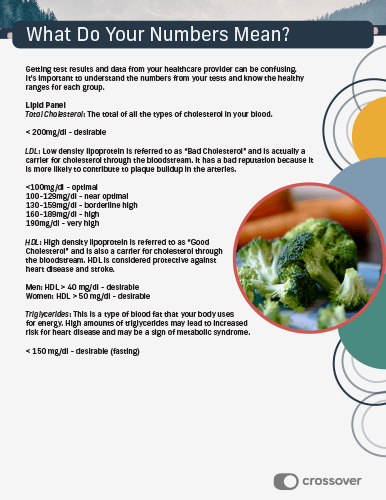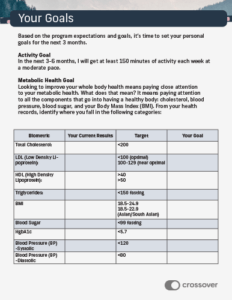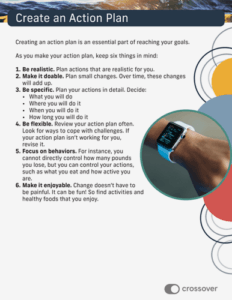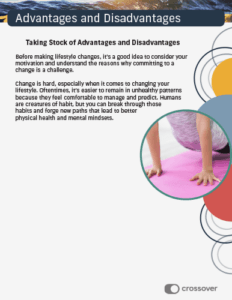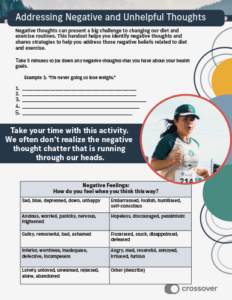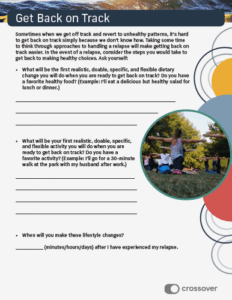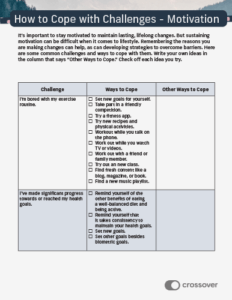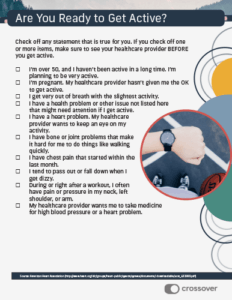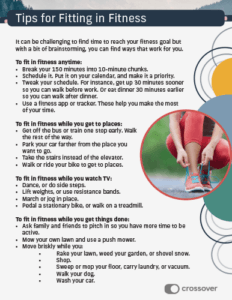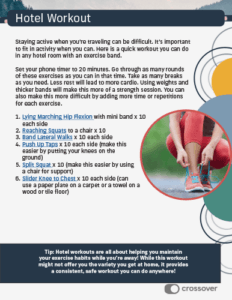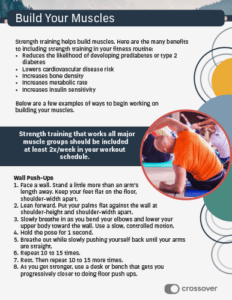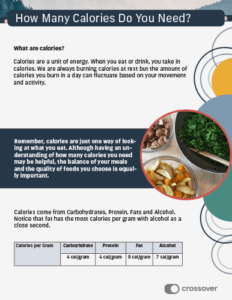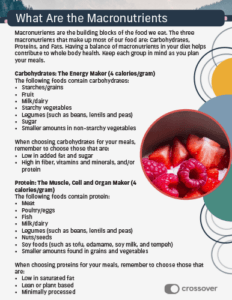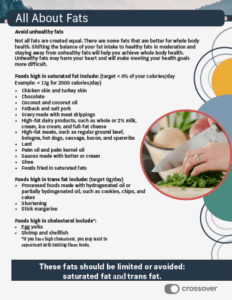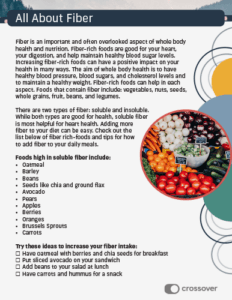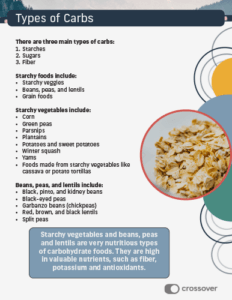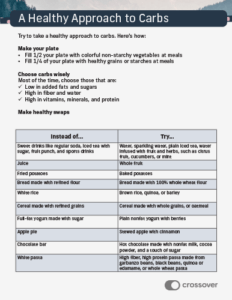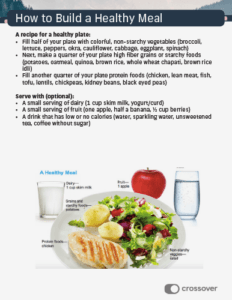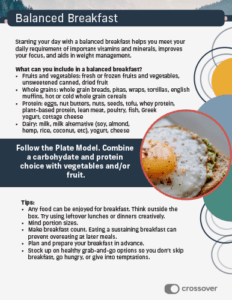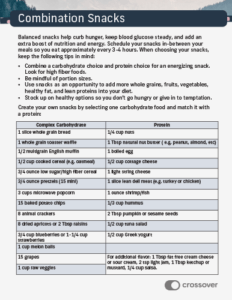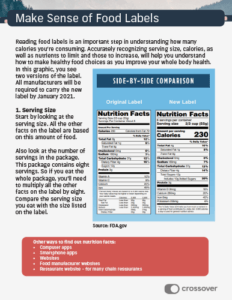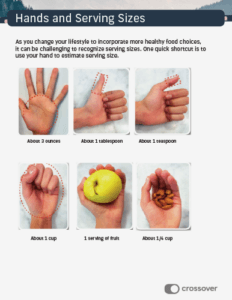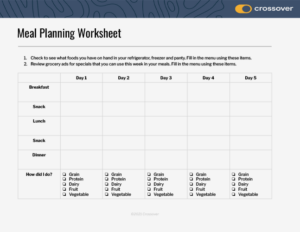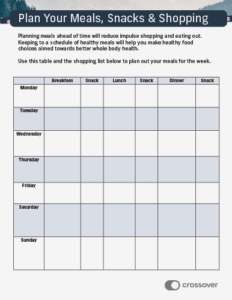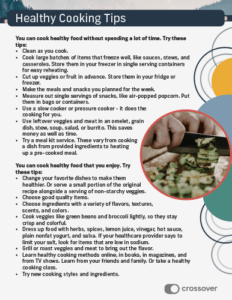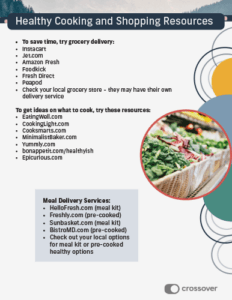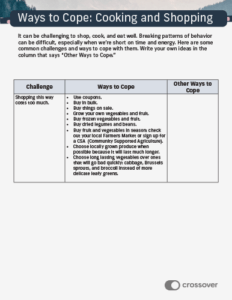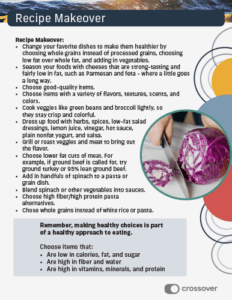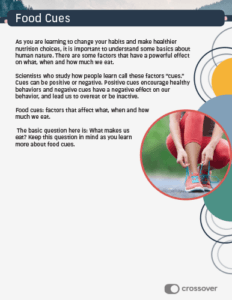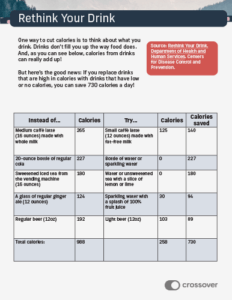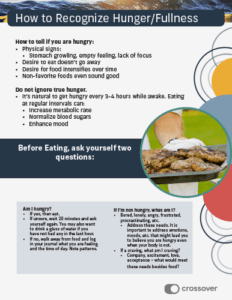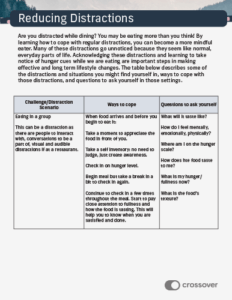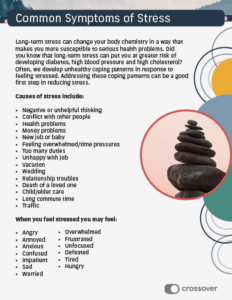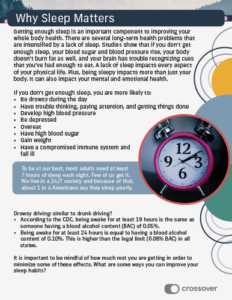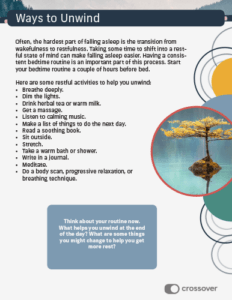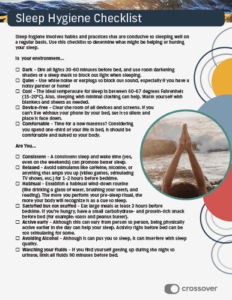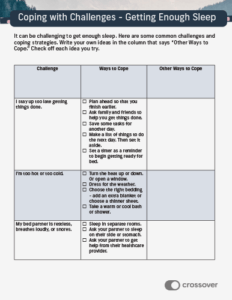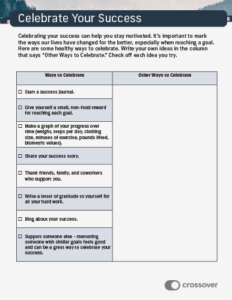
Metabolic Health
What is metabolic health? On this page, you’ll learn what metabolic health means and the lifestyle changes that can help you improve yours. We’ll talk about nutrition, movement, stress, and sleep, and the impact these areas can have on reducing your risk for metabolic syndrome and chronic disease.
Learn. Explore this module for in-depth info and useful videos.
Practice. Stick with the most helpful habits and exercises.
Let us help. Want more help? Connect with your Crossover care team.
EXPERT GUIDANCE PROVIDED BY:
-
Camilla Lee, NBC-HWCVirtual Health CoachCamilla is a registered dietitian nutritionist and a board-certified health and wellness coach. As a health coach at Crossover, she loves to help people set themselves up for success. This involves creating routines that make healthy choices feel easy and building consistent habits to bring balance and support self-care.
-
Danielle Heuseveldt, RD, NBC-HWCRegistered DietitianDanielle is the Health Coach Program Director at Crossover. She is both a registered dietitian and certified health and wellness coach. In addition to a wealth of knowledge, she brings passion, compassion, practicality, and a touch of fun to the coaching partnership with members, and works to encourage and empower them to live their best lives.
Metabolic health is a term used to describe how well your body uses and produces energy. To understand this concept, imagine your body is like a car. The “health” of a car has to do with how well it uses gasoline (or electricity) and how well it stops, starts, steers, brakes, and accelerates. A mechanic can’t tell much about how well a car functions just by looking at it. Instead, mechanics use a 30-point inspection system to determine this. The 30-point inspection measures everything from fluid levels and engine function to wear and tear on tires and brakes.
Like the 30-point inspection system for a car, metabolic health is a system of measurements. It’s used to determine important things about your health, because your doctor can’t tell how healthy you are just by looking at you or weighing you. Metabolic health measures a number of different levels in your body: blood sugar, triglycerides, high-density lipoprotein (HDL) cholesterol, and blood pressure, as well as your waist circumference. These five measurements tell your doctor how well your body is able to respond to the food you eat and how well it can make energy. Because every cell in your body requires energy to function, your metabolic health is really important to your overall health.
Metabolic syndrome is the term used when someone has three or more of the following:
- High blood sugar (a fasting glucose level above 100 mg/dL)
- High triglyceride levels (above 150 mg/dL)
- Low HDL cholesterol (less than 40 mg/dL)
- High blood pressure (130/85 or higher)
- A waist circumference of 35 inches or more for women and 40 inches or more for men
Metabolic syndrome is related to many chronic diseases. It’s also associated with worse brain function, energy, mood, skin health, and fertility. Unfortunately, only one out of every eight American adults are metabolically healthy. However, the good news is that many aspects of metabolic health are in your control. The best news of all? You can improve your metabolic health at any age. It’s never too late to get started.
Where Are You Now?
In order to set goals effectively, you have to know where you’re starting from. If you haven’t had a physical within the last year, make an appointment with your primary care doctor. When you make the appointment, request to have the necessary blood tests to determine your metabolic health. If you’ve already had these tests recently and you know your levels, you’re ready to start setting your metabolic health goals. The handout below can help you understand your test results and the healthy ranges for each.
Where Do You Want to Go?
Now, think about where you want to go. What improvements do you want to see with your metabolic health? Is weight loss something you’d like to work on? How about getting your blood sugar back to normal? Whatever your goals are, write them down, and make sure they are SMART (Specific, Measurable, Attainable, Relevant, and Time-Bound). The handout below can help you with this, or you can make an appointment with a Crossover health coach.
Creating An Action Plan
You may have heard that goals without a plan are just dreams. Use the handout below to help you , think about what actions you need to put in place to achieve your goals.
Change Is Hard
This is the point in the process where it’s important to acknowledge that change is hard, especially changes to your lifestyle. We know that you might have very good reasons for changing and also, at the same time, very good reasons for staying the same. This is known as ambivalence and it’s perfectly normal. One way to break free from ambivalence is to make the advantages of change outweigh the disadvantages. Check out this worksheet and video to learn how to do just that.
Now that you have your metabolic levels, your goals, and an action plan, let’s talk about mindset. As you already know, changing your habits can be easier said than done. Oftentimes, your mindset can hold you back from making the changes you want to see for yourself. However, being prepared for the ways your mind will fight against you can make all the difference for your success.
Dealing with Negative Thoughts
Sometimes, negative and unhelpful thoughts can drag you down and cause you to act in ways that go against your goals. The handout and video below can help you counter negative thoughts as they come up.
Addressing Negative and Unhelpful Thoughts
Dealing with Tempting Thoughts
In addition to negative thoughts, tempting thoughts seem to be around every corner, waiting to trip you up or keep you stuck in your same old routine. Use the worksheet below to identify and reframe your tempting thoughts.
Getting Support
One of the biggest challenges to making lifestyle changes can be getting support from the people around you. Friends, family, and coworkers mean well, but sometimes they can’t or won’t support you in your goals. The handout below can help you get support from the people around you.
Getting Back On Track
Maintaining our health is not always a straightforward path. Like with many things in life, sometimes it feels like we take two steps forward only to take one or several steps back. This is normal! Changing habits is hard, and you can expect to get thrown off track at times. The handouts below can help you accept setbacks, cope with challenges, and move forward in the pursuit of your goals.
10 Steps to Recover from a Relapse
How to Cope with Challenges – Motivation
If you are attempting to lose weight and your progress stalls, that can be particularly demotivating. The handout below can help you cope with stalls and get through them successfully.
The Benefits
No matter which aspect of your metabolic health you want to improve, increasing your daily activity level is a great first step. In addition to lowering blood pressure, cholesterol, and the risk of type 2 diabetes, getting enough exercise can also lead to:
- Better sleep and mood
- Improved balance and flexibility
- Lower risk of heart attack and stroke
- Lower stress levels
- Increased energy
- Stronger muscles
- Improved body composition
Safety
When adding exercise to your daily routine, safety comes first. Use the checklist below to help you avoid injuries or flare-ups of any preexisting conditions. If you check any of the boxes, talk to your doctor before getting started with your new activity.
☐ I’m over 50 and I haven’t been active in a long time. I’m now planning to be very active.
☐ I’m pregnant. My healthcare provider hasn’t given me the OK to start exercising.
☐ I become very winded or short of breath with slight activity.
☐ I have a health problem or other issue not listed here that might need attention if I start exercising or increasing my daily activity level.
☐ I have a heart problem. My healthcare provider wants to keep an eye on my activity level.
☐ I have bone or joint problems that make it hard for me to do things such as walking quickly.
☐ I have chest pain that started within the last month.
☐ I tend to pass out or fall down when I get dizzy.
☐ During or right after a workout, I often have pain or pressure in my neck, left shoulder, or arm.
☐ My healthcare provider wants me to take medicine for high blood pressure or a heart problem.
Here’s a handout of the checklist you can bring with you to your doctor:
If you didn’t check any boxes on the list above, or you were cleared by your doctor to begin an exercise regime or increase your daily activity, now it’s time to think about what else you might need to exercise safely. This could include:
- Dressing for the activity: Wear the right shoes and clothes and use safety gear as needed.
- Hydrate: Drink water before, during, and after your workout or activity, even if you don’t feel thirsty.
- Listen to your body: Slow down or stop if you feel very tired, sick, faint, or your joints hurt.
- Mix it up: Do a variety of activities to avoid straining any one part of your body.
- Start small: If you train too hard or too often, you may get hurt. Aim to make slow, steady progress over time.
- Warm up before you work out and cool down after. Take five to 10 minutes for each.
- Watch out. Be careful not to trip or bump into anything.
- Work with the weather: Exercise indoors if it’s too hot or too cold. If you become overheated, you may get a headache, a fast heartbeat, or you. may feel dizzy, sick to your stomach, or faint.
Using good form when strength training. Head over to our Strength Training page to learn more.
How Much Activity Do I Need?
It is recommended that you get at least 150 minutes of moderate physical activity or 75 minutes of vigorous physical activity each week. This should include at least two days of muscle strengthening activity, and should also include flexibility exercises. Sound overwhelming? It doesn’t have to be. Head over to our Exercise Basics page to learn more.
Getting Started
For some, getting started is the biggest challenge. When thinking about starting an exercise routine or increasing your activity levels, it can help to ask yourself these questions:
- What type of activity do you enjoy doing?
- What has worked for you in the past?
- What time of day might be best for you to exercise?
- When in the day is your energy highest?
One of the most important things to remember is that you want to make slow, steady progress. Don’t try to change everything at once, and don’t try to run five miles on your first try. Remember that you can increase your physical activity without spending hours in a gym, and that there are so many great ways to get active. Here are a few suggestions to get you started:
- Set an alarm to get up and walk the perimeter of your office building every hour.
- Dance to your favorite music.
- Pace the sidelines at your children’s or grandchildren’s sporting events.
- Play actively with your children or pets.
- Walk to the local farmer’s market.
- Run, bike, or walk quickly when doing errands.
- Start a new active hobby, such as biking or hiking.
- Take a walk after dinner with your family or by yourself.
- Take a walk with a coworker or by yourself during your lunch break.
- Plan walking meetings.
- Track your steps with a pedometer. Work up to 10,000 steps or more per day.
- Walk around whenever you talk on the phone or are on a conference call.
- Walk briskly when you shop.
- Walk up and down escalators instead of just riding them.
- Go to the bathroom, breakroom, or micro-kitchen on a different floor in your office building.
- Walk your dog each day.
- When you watch TV, stand up and move or do chores during the commercials.
- Take the stairs whenever possible.
- Get off the bus, train, or subway a few stops before your destination and walk the rest of the way.
If walking isn’t possible or comfortable for you, here are a few ideas to try:
- Strength training
- Water aerobics
- Chair dancing
- Chair yoga
- Stretching
- Biking
- Rowing
NEAT
Moving more means increasing your non exercise activity time! Did you know, you can burn hundreds of calories each day without adding additional time at the gym? Non-exercise activity thermogenesis (NEAT) is the name for any activity that burns calories outside of purposeful exercise. Incorporating small, quick changes to your normal routine can have a big effect on your metabolic health. Think about how you can fit more movement (no matter how small) into your life.
Fitting in Fitness
With all of life’s demands, fitting in daily activity can feel impossible. The handout below can help you find the time, even if you have a desk job.
Making Activity a Habit
It can be challenging to stay active. It’s important to remember the reasons why you’ve decided to make a lifestyle change, in order to stay motivated and excited to continue your journey. Here are some common challenges you might face and ways to cope with them:
| Challenge | Ways to Cope |
| I feel less motivated. | ☐ Know your “why.” Remind yourself every day why you want to stay active. Ask family and friends to remind you too.
☐ Plan ahead. Make physical activity a regular part of your schedule. Put it on your calendar. ☐ Commit to be fit. Work out with a family member or friend. ☐ Take a fitness class. ☐ Join a walking group. ☐ Keep it fun. Keep trying new ways to be active until you find some you enjoy. ☐ Watch videos or listen to music while you work out, or try a fitness app. ☐ Challenge yourself. Set new fitness goals for yourself or compete with a friend. ☐ Reward yourself. Give yourself small, non-food rewards for meeting your fitness goals. Ask family and friends to support you. |
| I have less time for exercise due to life changes. | ☐ Work out while you get things done. Move briskly while you sweep the floor, mow the lawn, shop, or walk your dog.
☐ Make screen time active time. Lift weights, ride a stationary bike, or march in place while you watch TV. ☐ Catch up with friends and family by taking a walk together, or walk while you talk on the phone. ☐ Walk to get places instead of driving. Ride your bike to work.. ☐ Take the stairs instead of the elevator. ☐ Break your 150 minutes of daily activity into 10-minute chunks. ☐ Ask family members to pitch in with daily tasks so you have more time to be active. |
| I have less money due to life changes. | ☐ Do free fitness activities like walking, hiking, or dancing.
☐ Buy workout clothes and supplies on sale. ☐ Look for free fitness classes online or at your local community center. ☐ Ask about needs-based fees at the gym. ☐ Take advantage of free trials for different studios and apps. |
| The weather is making it hard to walk outdoors. | ☐ Dress for the weather.
☐ Walk in a mall. ☐ Find an activity you can do indoors. |
| I’m injured. | ☐ Ask your healthcare provider how best to treat the injury.
☐ Find another way to be active. For instance, if your foot hurts, you may still be able to swim. |
Many factors (or cues) in your environment can lead you to being inactive. For example, after dinner, you may automatically sit down in front of the TV. Remember that every day, you have a choice to do something different. You could choose to take a walk after dinner instead of watching TV. To become active regularly, you must add positive activity cues into your life. Over time, the cues will help to create a regular pattern of activity.
Take a look at the handout below for more information on building positive activity cues.
Finally, think about getting help. Crossover has fitness trainers who can help you start your movement journey safely. They even offer FREE fitness assessments and fitness classes. Visit the Fitness page to learn more and sign up.
Once you have established a habit around exercise, you can begin to level up your practice for even more benefit. Check out the resources below for tips on how to stay active even when you’re away from home and how to incorporate strength training into your fitness routine.
Movement Away From Home
Being active away from home (and away from your routine) can be challenging. Here are a few resources that can help you maintain your activity level, no matter where you are.
Ways to Cope – Getting Active Away from Home
Get Strong
In addition to helping build muscles, strength training:
- Reduces the likelihood of prediabetes or type 2 diabetes
- Lowers cardiovascular disease risk
- Increases bone density
- Increases metabolic rate
- Increases insulin sensitivity
Check out the resources below for strength training exercises you can incorporate into your exercise routine:
Check out the Strength Training Basics page.
Eating well is an important part of improving your metabolic health and reaching your health goals, but it can often feel overwhelming and confusing at first. In this section, you’ll learn the building blocks of healthy meals and snacks.
Calories
Calories are a unit of energy. Everything you eat or drink (except water) contains calories. Your body is constantly burning calories, even when you’re at rest. The more activity you do, the more calories you burn. The handout below will help you determine how many calories you should be consuming per day.
Macronutrients
Macronutrients are the building blocks of everything you eat or drink. The three macronutrients that make up most of what you consume are: carbohydrates, proteins, and fats. Having a balance of macronutrients in your diet helps contribute to whole-body health. Take a look at the handouts below to learn more about macronutrients.
Putting It Together
While it’s helpful to know about calories and macronutrients, it’s not practical to think of your meals in these terms. Use the handouts below for tips on how to build healthy meals and snacks.
Tracking
Tracking calories, macronutrients, or meals can be a helpful tool to see patterns in your eating habits, and to give you clues on where you might be consuming too much or not enough. Also, in order to track, it’s helpful to have information about labels and serving sizes. Take a look at the handouts and videos below for tips on tracking, food labels, and serving sizes.
How to Cope With Challenges – Tracking Food
Everyday Objects and Serving Sizes
Now that you’ve covered the basics of nutrition, you’re ready to learn even more useful tools.
Meal Planning
Meal planning can be a game-changer for your health and fitness goals. The handouts below will teach the basics of meal planning, cooking, and shopping. If you need some help, our health coaches at Crossover are available to make these tools work for you.
 Basic Meal Planning Guidelines
Basic Meal Planning Guidelines
Plan Your Meals and Shopping List
The resources below are full of valuable information on shopping and cooking.
Healthy Cooking and Shopping Resources
Ways to Cope-Cooking and Shopping
Ways to Take in Fewer Calories
Food Cues
Have you ever thought about WHY you eat? The factors that affect what, when, and how much you eat are called food cues, and they can be positive or negative. Positive food cues lead to choices that are more in line with your goals. Negative food cues can lead you to eating too much, eating late at night or between meals, or eating foods that you don’t really want or even enjoy. Read the handout below for more information on food cues.
Eating Away from Home
While preparing food at home can often make it easier to stick to your goals, eating out is often necessary and, in our opinion, fun! Eating out can definitely be part of your life, even while you’re working on your health goals. Take a look at the handouts below for more information.
Beverages
We’ve talked a lot about what you eat, but what about drinks? Drinks can be a source of added sugar and calories without providing helpful nutrients such as vitamins, minerals, or fiber. So, choosing your beverages carefully can be an easy way to work toward your health goals. The handouts below will help you make the best drink choices.
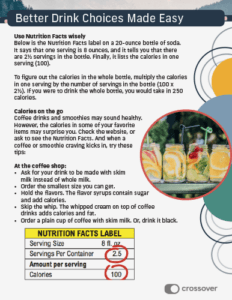
Now that you’ve learned the what, why, and how of eating, let’s talk about a way of eating that helps you put it all together. Mindful eating allows you to slow down and think about why you are choosing to eat, what’s going on around and within you, and helps you be fully involved in the process of eating. Check out the videos and handouts below to learn more.
Getting Started with Mindful Eating
The table below explains the principles of mindful eating. Pick a principle you’d like to try and give it a shot at your next meal. Remember, you don’t have to do all of these at once, or at every meal. Start slowly and see what works. For more information on each of the principles, check out the resources below the table.
| Raise Your Awareness | Practice tip: Before eating, check in with yourself. how hungry are you? Are you thirsty? What are you feeling? When you eat, use a plate so you can truly see how much you’re serving yourself. |
| Reduce Distractions | Practice tip: Turn off all screens, put away all work and reading, and sit at a table or counter. |
| Look at What You’re Eating | Practice tip: Does the portion you’re taking match your hunger? Are you eating a variety of foods? Try using a smaller plate or bowl to help control your portion size. At a restaurant, ask them to pack half of you meal to go when you order. You might realize you’re satisfied with less. |
| Eat More Slowly | Practice tip: Put your fork down between each bite. Drink water between bites. And chew your food thoroughly. Try to spend 20-30 minutes eating each meal. |
| Enjoy Your Meal | Practice tip: Make the environment pleasant and use your senses to enjoy the meal. Look at your food, smell it, and notice how it tastes. |
Resources for “Raise Your Awareness” principle:
How to Recognize Hunger Fullness
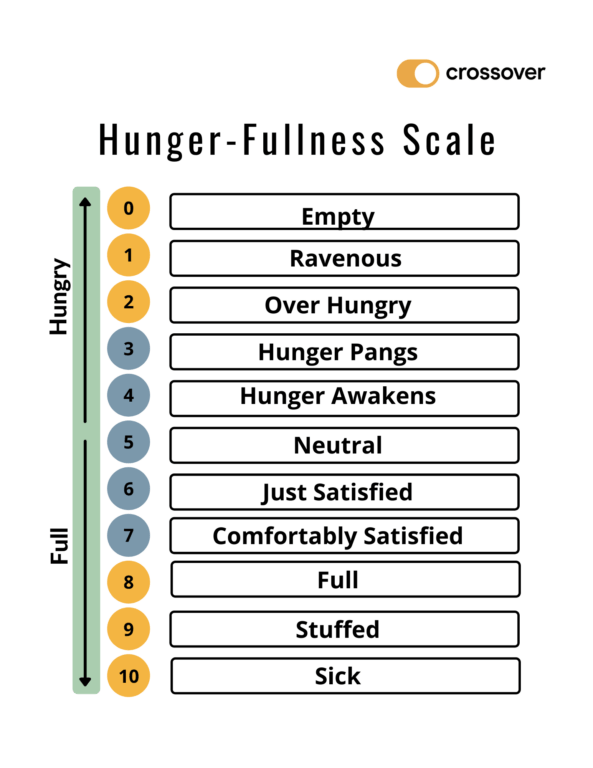
Stress can have a strong influence on your overall health. Stress can make managing your blood sugar more difficult, interfere with your sleep, drain your energy levels, and increase your hunger and cravings. In this section, you’ll learn how to recognize and manage stress. To begin, use the handout below to identify the causes of stress in your life.
Once you’ve identified where your stress is coming from, you can start to develop ways to cope with it. The resources below can help you identify coping strategies.
Healthy Ways to Cope With Stress
Stress can be difficult to manage at times. For a deeper dive on this subject, check out the Stress and Resilience page. Also, consider making an appointment with a Crossover mental health therapist if your stress feels like too much to manage on your own.
What does sleep have to do with your metabolic health? As it turns out, quite a bit! The resources below will help you discover why sleep matters and how to improve yours.
Now that you understand why sleep is important, the next step is to work on getting enough good-quality sleep.Take a look at the resources below for improving your sleep quantity and quality.
Celebrating your success can help you stay motivated. It’s important to mark the ways your life has changed for the better, especially when reaching a goal. Take a look at the resource below for some healthy ways to celebrate.
Your Crossover care team is here to help. We have coaches who can make a plan so you know where to start. Our mental health team can talk you through your stress and anxiety. Our physical therapy team can help you recover from injury with safe movement. Or you can start with a physical for a full picture of your overall health. Wherever and whenever you’re ready to begin, just connect with your Crossover care team. We want you to be well.
Many of the resources you see on this page come from or were adapted from the CDC’s Diabetes Prevention Program. To learn more, visit the National Diabetes Prevention Program Website.


